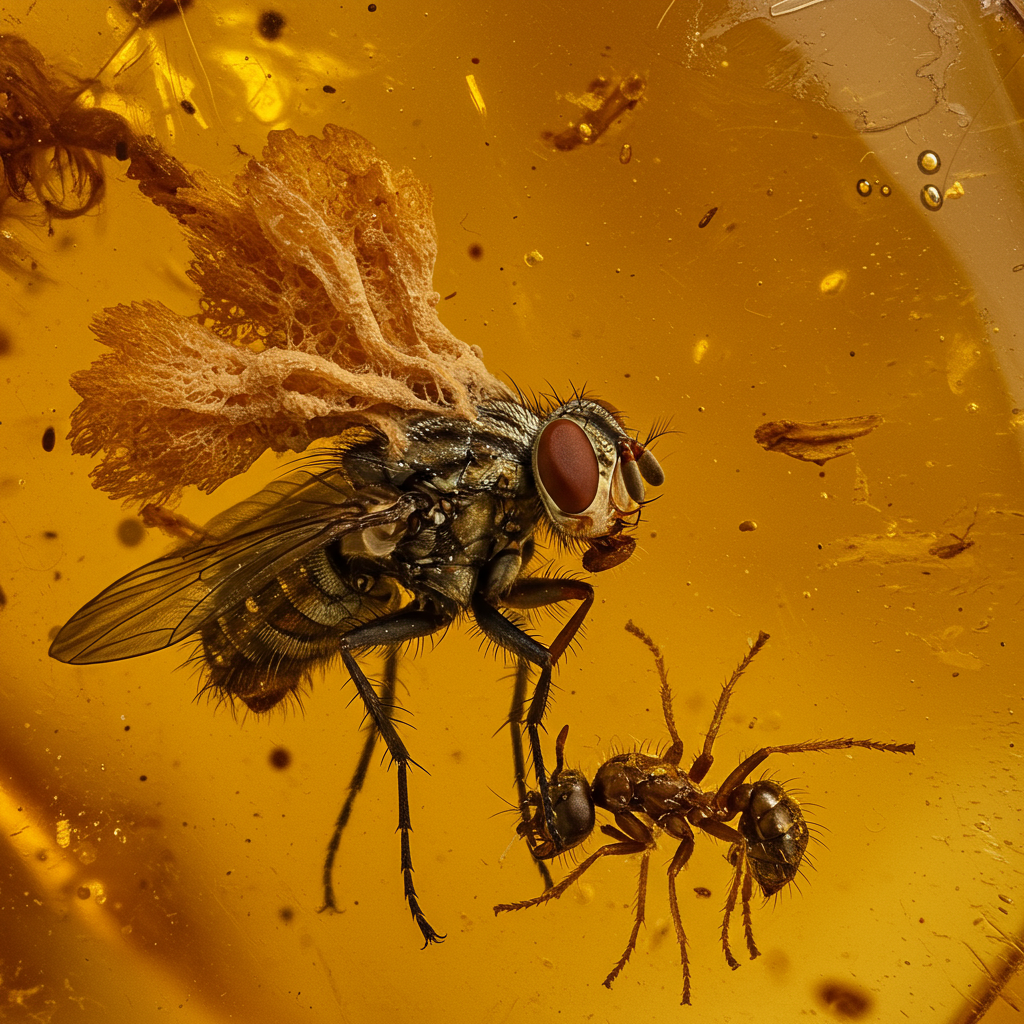A chilling discovery from 99-million-year-old amber reveals that parasitic fungi, akin to the “zombie” types popularized in shows like The Last of Us, preyed on insects during the age of dinosaurs. Encased within a ancient glob of tree resin, scientists have found two remarkable specimens: a fly with the tell-tale fruiting body of a fungus erupting from its head and a young ant also infected with a similar parasitic growth.
These incredibly preserved fossils represent some of the oldest known examples of entomopathogenic fungi – parasites that infect and often take control of insects before ultimately killing them.
A Glimpse into Cretaceous Ecosystems
“Amber gives us this opportunity to visualize the ancient ecological relationships preserved in fossils,” explains Yuhui Zhuang, a doctoral student at Yunnan University and lead author of the study published in the journal Proceedings of the Royal Society B: Biological Sciences.
Such fossils are exceedingly rare. Zhuang notes that among the tens of thousands of amber specimens examined, only a handful capture this specific symbiotic relationship between fungi and insects.
Using advanced techniques like optical microscopy and micro-computed tomography (micro-CT) for 3D imaging, Zhuang and his colleagues identified two previously unknown species of ancient fungi from the genus Ophiocordyceps. The fungus found on the ant was named Paleoophiocordyceps gerontoformicae, while the one on the fly was dubbed Paleoophiocordyceps ironomyiae.
Ancient Predators Shaping Life
The Ophiocordyceps genus is infamous today for the “zombie-ant fungi,” species that can manipulate their ant hosts’ behavior for optimal spore dispersal – a real-world phenomenon that inspired the fictional fungus in The Last of Us.
“The discovery of these two fossils suggests that terrestrial ecosystems were already very complex, and that Ophiocordyceps, in particular, may have begun to act as ‘predators’ of insects in the Cretaceous period, regulating the populations of certain groups,” Zhuang commented via email.
Paleontologists believe Paleoophiocordyceps likely employed similar zombifying tactics to their modern relatives. Conrad Labandeira, a senior scientist at the Smithsonian Museum of Natural History, notes that modern carpenter ants infected by Ophiocordyceps spores experience the fungus entering their brain, allowing the parasite to control the ant’s movements. Ants appear to have been targeted early and remain major hosts, while flies are rarely affected today, making the fossilized infected fly particularly noteworthy.
Study coauthor João Araújo of the Danish Natural History Museum suggests the ancient ant fungus species could be an ancestor to modern zombie-ant fungi, similarly controlling its host. However, very few ancient parasitic fungi fossils exist, leaving much unknown about their evolutionary history.
Scientists believe the fungi likely killed their insect hosts shortly before they became trapped in the sticky resin that would fossilize into amber. This killing is typically part of the fungal life cycle, allowing the fruiting body to emerge for reproduction.
Untold Ancient Diversity
Phil Barden, an associate professor at New Jersey Institute of Technology who works with amber fossils but was not involved in this study, highlights how such finds offer only a limited view into past ecosystems. “Even as we find a remarkable diversity of organisms entombed in amber, it’s important to remember that we really do only capture the smallest glimpse,” he said. “For any given fossil ant or beetle, we can imagine all of the parasites, fungus, and bacteria that such insects support.”
Edmund Jarzembowski, a professor at London’s Natural History Museum and coauthor, expressed fascination that the bizarre aspects of the natural world we observe today were also present millions of years ago, during the height of the dinosaurs.
The fossils were sourced from Myanmar’s rich amber deposits. The study notes the specimens were acquired before 2017 and, to the authors’ knowledge, were not connected to ongoing armed conflict or ethnic strife in the region, addressing ethical considerations surrounding the provenance of Myanmar amber.




